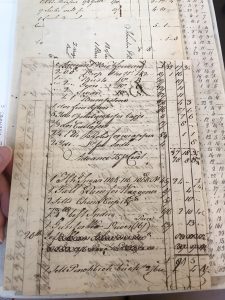Cara Siliakus
AMST 276
10 October 2018
(see photos below)
Photo Caption #1
The object I chose for my time period, Developing a National Cuisine (1700-1800), is an expense/invoice correspondence including food items between Richard Bennehan of the Cameron Family, his business partner William Johnston and their associate James Gibson in Suffolk, Virginia on October 16, 1774. The Cameron family of Orange County became one of North Carolina’s wealthiest families in the 19th century, and Richard Bennehan was the first member to relocate from Virginia to Hillsborough, North Carolina, in 1768 when he received an offer to partner with William Johnston in the Little River Store near Hillsborough. The business was prosperous and the store outsourced goods from merchants in the southeastern United States, including James Gibson in Suffolk. This particular object is a report of various goods for the store which include items like silk, gunpowder and linen. More importantly, however, it includes several food items, including rum, tea, cream, vinegar, pepper, alum, goose and swan.
This object is important for several reasons, chiefly that it provides an insight. Through the document, the reader gets a glimpse of the types of food items being sold at this time and in the Chapel Hill area specifically. Because these items were sold by the Little River Store, arguably a popular and essential location where people purchased goods, they can be considered staple items for people in this area as the United States was only beginning as a nation. It provides what items were the most common and important, emphasizing the popularity of rum and tea as inexpensive beverage choices and side ingredients and spices like vinegar and pepper that could be used in a large variety of dishes. However, the presence of goose and swan provides a different category of item that could possibly indicate the Little River Store’s appeal to wealthier customers. This indication comes from the English custom of swans typically being reserved for the Queen of England and those of high status, wealth and nobility to eat them, as well as representing luxury (Smithsonian). Geese have long been served as a customary meal on holidays and special occasions, also making it more of a delicacy and novelty food item.
This object is important to Chapel Hill food ways history because it shows what kind of items were most popular for people to be buying at this point in time in the Orange County area and how they more generally shape the national cuisine that was beginning to develop at the end of the 19th century.
Signed: Cara Siliakus

Page 1 of 3 of Business Invoice from Cameron Papers. Correspondence between Richard Bennehan of the Cameron family, his business partner William Johnston and James Gibson, a merchant from Suffolk, VA. Items on this page include cream and vinegar.

Page 2 of 3 of Business Invoice from Cameron Papers. Correspondence between Richard Bennehan of the Cameron family, his business partner William Johnston and James Gibson, a merchant from Suffolk, VA. Items on this page include pepper and alum.

Page 3 of 3 of Business Invoice from Cameron Papers. Correspondence between Richard Bennehan of the Cameron family, his business partner William Johnston and James Gibson, a merchant from Suffolk, VA. Items on this page include goose, swan and rum.
Citations:
Subseries 2.1.1. Antebellum Accounts, 1767-March 1861, Folder 1908, October 16, 1774], in the Cameron Family Papers #133, Southern Historical Collection, Wilson Library, University of North Carolina at Chapel Hill.
Background and Biographical Information in the Cameron Family Papers #133, Southern Historical Collection, Wilson Library, University of North Carolina at Chapel Hill.
“The Fascinating, Regal History Behind Britain’s Swans.” Smithsonian.com, Smithsonian Institution, 31 July 2017, www.smithsonianmag.com/history/fascinating-history-british-thrones-swans-180964249/.